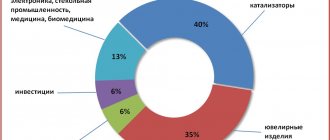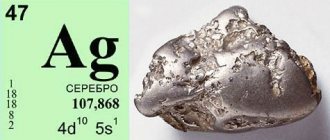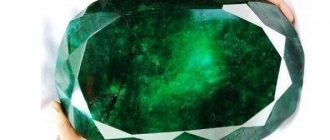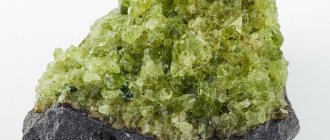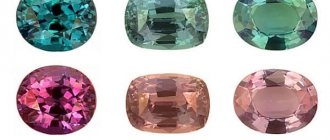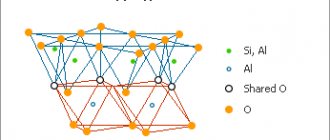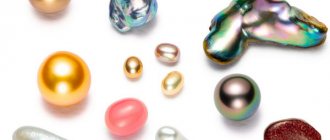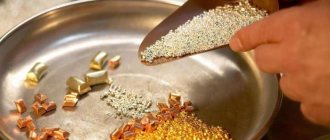Brief description of platinum
Editorial
Promdevelop editorial team
Platinum is a chemical element, a metal (platinum formula - Pt), and, moreover, a very rare one.
- Catalysts
However, this does not negate its wide range of applications - from jewelry to pacemakers. Platinum is a precious metal that is part of the so-called transition group, joining gold, silver and copper. Due to its atomic structure, platinum is able to easily bond with other elements.
History of discovery and origin of the name of the metal
The first mention of this substance dates back to 1557, when the Italian physician and humanist Julius Caesar Scaliger described the metal he found in Central America. It was not possible to melt this metal using the means and methods that existed at that time and were available to the Spanish conquistadors. Therefore, Scaliger named the new chemical substance platinum, which can be translated as “little silver” or even “little silver.”
Silver: origin and unique properties, mining technologies, application today
This name reflected both the color of the metal (silver-white) and its practical uselessness to people of that era. Therefore, at first, ancient metallurgists in Egypt and America used the metal to make jewelry and decorative items, mixing it with more easily melting gold. This may be why the metal was called white gold for quite a long time. The analogies were obvious - it, like gold, proved to be extremely resistant to tarnishing and corrosion. On the other hand, the element is very plastic and pliable: it can easily be deformed, pulled into a wire, etc. Finally, platinum is a full-fledged noble metal, since it does not oxidize and is not affected by ordinary acids.
Being in nature. Isotopes
World reserves of platinum are small. The metal content in the earth's crust is 5 · 10-7 wt.%. It is found both in pure form and in compounds. The most important minerals are polyxene, which contains 6...10% iron, as well as palladium platinum, ferroplatinum, iridoplatinum, sperrylite PtAs2, as well as a number of more complex chemical compounds, including nickel, sulfur, palladium. The most famous of these minerals is braggite. It occurs together with copper and iron pyrites in contact with gold ore, crystallizing in cubic or, less commonly, octahedral form. Braggite has a metallic luster and also contains traces of rhodium and antimony.
To date, scientists have discovered quite a lot of isotopes of this element: 6 natural and 37 artificial. Most common isotopes:
- Pt195 (33.83% of the total).
- Pt194 (32.97% of the total).
- Pt196 (25.24% of the total).
- Pt198 (7.16% of the total).
- Pt192 (0.78% of total).
- Pt190 (0.01% of total).
Crystallographic characteristics
system ; hexaoctahedral c. With. 3L44L36L29PC. Space group Fm3m (O5h). a0 = 3.9158. a0 = 3.924 A (pure Pt), 3.831 A (pure Ir), Z = 4
The crystal structure is close-packed cubic - atoms at the sites of a face-centered cubic lattice (Cu type).
The appearance of crystals. In combinations of faces, in addition to the dominant form {100}, {110}, {210}, {310} and some others are observed. Of the twins, twins of germination along (100) and fusion along (111) are predominantly developed. Polyxene crystals of skeletal development are known.
Place of Birth
Platinum mining in the world is concentrated in South Africa (80% of global production), Russia and Canada. Latin American platinum reached Europe only in 1735. The metal was also discovered in Brazil in the mineral syenite, where it is found together with gold.
Where is platinum mined? Among the largest deposits:
- Ural alluvial deposits discovered in the Nizhny Tagil region;
- Lapland mines (Finland), where the metal is bound together with diamonds;
- Deposits in the Canadian provinces of Ontario and British Columbia, as well as in large areas adjacent to the Yukon River Valley.
Platinum deposits in Russia, in addition to the Urals, are also located beyond the Arctic Circle, in the Norilsk region. Formally, Germany (Rhine Valley), Indonesia (Borneo Island), Spain, Ireland, USA, Australia and New Zealand are also considered platinum mining countries. The volume of production there is small and does not yet have global economic significance.
Among the exotic methods of production, it is worth mentioning meteorite iron, which often contains this metal.
How much platinum is mined in the world annually?
As can be seen from Table 1, about 450 tons of platinum group metals are mined worldwide per year. Of these, platinum makes up less than half. By comparison, annual global gold production is about 3,000 tons, about 15 times more than platinum.
Table 1. World production of PGMs, tons.
| 2008year | year 2009 | 2010 | 2011 | year 2012 | |
| Platinum | 193 | 184 | 192 | 200 | 183 |
| Palladium | 206 | 195 | 203 | 213 | 201 |
| Other platinum group metals | 69 | 69 | 71 | 73 | 68 |
| Total | 468 | 448 | 466 | 486 | 452 |
(according to USGS)
The main suppliers of platinum group metals are South Africa, Russia, Canada, USA, Zimbabwe, Botswana (see Table 2). Japan also mines PGM, but extracts it as a by-product from imported ore.
Table 2. World production of PGMs by country, tons.
| 2011 | year 2012 | |
| Platinum | ||
| South Africa | 148,0 | 133,0 |
| Russia | 25,9 | 24,6 |
| Zimbabwe | 10,8 | 11,0 |
| Canada | 8,0 | 7,0 |
| USA | 3,7 | 3,6 |
| Japan | 1,7 | 1,5 |
| Other countries | 1,9 | 2,3 |
| Palladium | ||
| Russia | 84,3 | 82,0 |
| South Africa | 82,7 | 74,0 |
| Canada | 14,3 | 12,2 |
| USA | 12,4 | 12,3 |
| Zimbabwe | 8,2 | 9,0 |
| Japan | 7,5 | 7,0 |
| Botswana | 2,1 | 2,6 |
| Other countries | 1,5 | 1,9 |
| Other platinum group metals | ||
| South Africa | 58,1 | 53,0 |
| Russia | 12,5 | 12,0 |
| Zimbabwe | 1,8 | 2,2 |
| Canada | 0,8 | 0,7 |
(according to USGS)
Mining and production technologies
How is platinum mined? The extraction method is determined by the form of platinum in nature, in the raw materials. For example, the majority of platinum ore mined in British Columbia is coarse and in the form of nuggets that are found in relatively small areas. Nuggets rarely weigh more than half an ounce (14 grams). Most of the metal is found in small grains, which platinum producers separate into magnetic and non-magnetic. The latter make up a large proportion of the total.
What is ore? What types of ore are there? How do they get it? Leading countries in ore mining
Pure metal often contains traces of nickel, as evidenced by spectrochemical studies of samples from Russia, Spain and America. For example, during platinum mining in Russia, samples from Kitlim contain at least 0.1% nickel, and Nizhny Tagil magnetic raw materials contain up to 0.75% nickel. Physical properties
The element is one of the densest - 21,450 kg/m3, which is more than 21 times the density of water or 6 times the density of diamond. Among the main properties of this metal:
- Atomic weight - 195.1.
- Melting point -1768.4 0C.
- Boiling point - 3825 0C.
For industrial applications, the magnetic properties of a given metal are important. The non-magnetic form is more common and has a higher density. Magnetic properties are determined by the presence of iron in the ore. Interestingly, some samples of Ural platinum attract iron filings more strongly than a regular magnet.
Platinum coins of Russia
12-ruble platinum coin of 1839
The issue of Russian platinum coins did not last long, but became one of the most significant events in the life of the metal. Their minting began in 1828 and lasted until 1845. During this time, more than 14 tons of coins were issued in denominations of 12 rubles (only 3,303 pieces were created), 6 rubles (17,582 coins were minted) and 3 rubles (1,372,000 pieces were issued).
Advertising - Continued below
Chemical properties
The first chemical studies were carried out back in 1741 by the British scientist Charles Wood. It was he who first called this element a metal (the eighth among those known at that time), and described some of the characteristics of platinum.
Reactivity
The history of platinum includes a test of "nobility". The metal passed it thanks to the research of British chemists William Wollaston and Smithson Tennant. At the beginning of the 19th century, they tried to dissolve purified platinum in a mixture of nitric and hydrochloric acids. After the metal was separated from the rest of the solution, palladium, rhodium, osmium, iridium, and later ruthenium were found in the waste. It is characteristic that mining today is carried out using a similar technology: samples containing the element are dissolved in an acidic environment, separated from the rest of the solution and by-products, and melted at very high temperatures to obtain pure metal.
Application of platinum
Platinum cylinders have long been used as the international standard for measuring weight. Nowadays the metal is used to create high-strength parts for various machines, tools and jewelry. Due to its very low level of reactivity, the element is used in some anti-cancer drugs.
According to the latest data, about half of cancer patients use platinum-containing drugs, since the antitumor properties of platinum have already been well studied. The metal is also used in pacemakers, dental crowns, and other devices due to its high resistance to corrosion from body fluids and lack of reactivity to vital functions. Where else is platinum used? In combination with cobalt, this metal is used to create strong permanent magnets, which are used in watch mechanisms, engines, and medical equipment.
Approximately a third of the world's consumption of platinum as a precious metal comes from jewelry. In particular, most large diamonds are inserted into platinum cases.
Catalysts
Almost half of the mined platinum is used in catalytic converters - car components that reduce the toxicity of exhaust gases to acceptable levels. They can withstand the high temperatures necessary for oxidation reactions, during which the toxicity of emissions is reduced. In addition, platinum is used as a catalyst in the production of fertilizers, plastics and gasoline.
Monetary functions. Marks of Excellence
Since platinum is a precious metal, in many countries it is stored in the form of bullion, which can be used for interbank payments. Commemorative signs are also produced. However, due to limited reserves, the production volume of such items, in comparison with gold or silver, is small.
Everything about gold mining. Where and how is gold mined?
How is native platinum mined?
First of all, we need to find platinum-bearing sands, and there are few of them. The largest Konder deposit is located in the north of the Khabarovsk Territory in the Ayano-Maisky district. Since the start of operation in 1984, 90 tons of this precious metal have been mined here. True, at first glance it is not very attractive. It looks like metal shavings from a large file, and the nuggets look like potatoes. More beautiful are collectible crystals in a gold shirt (edge 0.5-1 cm). They came only from the Anomalny stream and are no longer mined.
So, we fly by AN-24 plane from Khabarovsk to the mining village of Mar-Kuel. Further along a decent taiga highway, 4 hours by car to the upper village of Konder and 15 minutes to the ring ridge. Many people mistake it for an astrobleme (the trail of a large fireball), but this is not so. The ideal ring structure is formed as a result of rock weathering processes.
At the test site, washing devices - modern decks - operate around the clock. First, bulldozers remove the top layer of waste rock—called overburden—and feed platinum-bearing sand onto the hydraulic cradle table. This is a large sieve with 10 centimeter holes. The monitor uses a water cannon to throw large stones (galya, from the word pebbles) into the dump, and sand and nuggets through holes on the table fall inside the hydraulic cradle and are fed with water under pressure through an inclined pipe into the deep filling airlock (the deck itself). Its bottom is covered with ribbed rubber mats (modern sheep skin), pressed down with steel gratings. Here the platinum heavy sand settles and the waste rock flies with water into the ephelium dump (ephelium).
Once a day in the morning, a film crew of three people climbs onto the deck. Why does the magic number three appear? According to the safety rules, a team of at least three people can work with precious metals: one will steal, two will agree and also steal, and the third will pawn. Such a practice!
We open the sealed covers of the deck, lift the grates and let low water flow along the bottom of the lock. Then we make some circular movements with our feet (butOrim) - the remains of the waste rock are carried away to the dump. And the platinum gets stuck between the ribs of the mats. We collect the metal from the mats into a 20-liter container and seal it. That's it, the shooting is over. From 100 grams to tens of kilograms of platinum are mined per day from one device. Next, we take the containers on a surveying machine to the concentration processing plant (SHF), where we perform the final purification of the metal from waste rock using a jigging machine and a concentration table. The platinum is dried and handed over to the PPK (platinum collection desk). There it is weighed, packed in bags, sealed and transported by plane to the mainland.
It must be said that after the SHF they hand over platinum with admixtures of iron, osmium and iridium. At the refinery in Krasnoyarsk, the metal is brought to 99.96% purity, cast into ingots and sent to the Motherland. This is part of our gold and foreign exchange reserves!
Currently, additional exploration is being carried out in the Conder ring to search for primary platinum. This can ensure an increase in platinum production, and therefore metal reserves, by several times!
Yes, I forgot to warn you. Without approval from the management of the Amur artel, which has a license to develop the field, you will not be allowed there - they will not even put you on the plane in Khabarovsk. So, agree or get a job in the artel.
Tags: platinum, mining, metal, work, platinum mining
Platinum price and forecast
Annual production does not exceed 120...130 tons. Investment activity in the market is determined by significant price fluctuations (see Where to invest money?). How much is platinum worth? Starting from February 2021, the price of platinum has been falling, and, according to experts, is predicted at 29...32 US dollars per gram. However, the platinum exchange rate and price dynamics over recent years have been seasonal: by summer, the cost of the metal usually increases. The platinum forecast for 2021 shows that investment risks from investing funds are quite high: over the past 6 years, the price of a gram of this metal has almost halved: from 59 to 31 US dollars per gram.
Price per 1 gram today
Currently, the demand for platinum is growing steadily, mainly due to the automobile industry. Daily platinum quotes on the exchange are available to our visitors online.
Platinum | RUB | 1 Gram
USDRUB*PL1!*10000000/311034768 chart provided by TradingView
Platinum | USD | 1 Gram
Chart PL1!*10000000/311034768 courtesy of TradingView
Platinum | RUB | 1 oz
USDRUB*PL1 chart! provided by TradingView
Platinum | USD | 1 oz
Schedule PL1! provided by TradingView
You can also take consolidated data from the interactive table.

